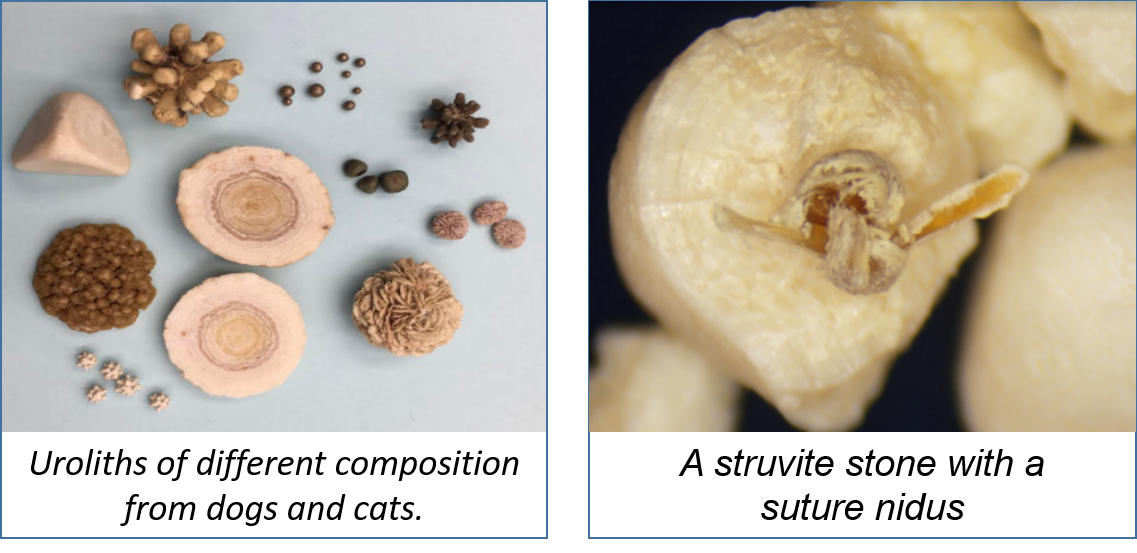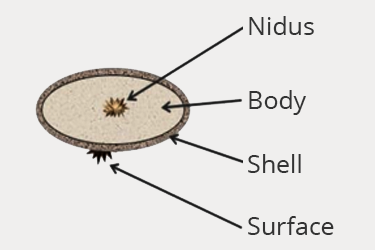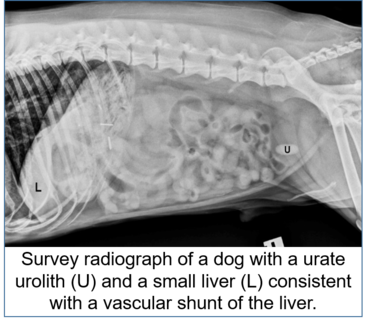Image of the month
Urolith basics
What are uroliths?
Uroliths (also known as calculi or stones) are solidified aggregates of mineral and nonmineral crystalloids that form in the urinary tract when urine becomes oversaturated with crystallogenic precursors. Most uroliths are composed of biogenic minerals, but also form from drug metabolites, amino acids or over foreign substances such as suture material from a previous surgery.

What is the anatomy of a urolith?

|
Structure |
Description | Significance |
|---|---|---|
| Nidus | Area of obvious initiation of urolith growth, which is not necessarily the geometric center of the sample. |
In general, the mineral type(s) in the "nidus" layer should be the primary focus of preventative measures because the nidus is the area of urolith initiation. Preventing a nidus of foreign material such as a suture, plant, etc. is also important to prevent urolith recurrence. |
| Body | The major portion of the urolith. | The "body" layer comprises the largest bulk of the sample. If no nidus layer is listed (or the nidus is similar in composition to the body layer), this should be the focus of preventative measures. |
| Shell | A complete outer concentric lamination of the urolith. | Shell and/or surface layers represent the most recent activity in the urolith formation process. Often, shell and surface layers that are significantly different from the composition of the body layer reflect changes in diet, medication, or the patient's medical condition. |
| Surface | An incomplete outer lamination of the urolith. | See "Shell" significance above. |
Why submit uroliths for analysis?

Developing strategies to minimize urolith recurrence requires knowledge of its composition. Urolith composition is a clue to the underlying diseases responsible for their formation. Submit all or a representative number of uroliths to obtain an accurate analysis. How to submit uroliths
What methods of analysis are recommended?
- Quantitative analytical methods are most accurate. The Minnesota Urolith Center uses optical crystallography, infrared spectroscopy, x-ray diffraction, energy dispersive techniques, and other methods to quantitatively analyze each layer in uroliths.
- Qualitative analytical methods are less reliable. This method uses chemical tests to identify chemical radicals and ions. Several components in stones cannot be identified chemically.
How can uroliths be retrieved for analysis?
- Voluntary voiding
- Catheter retrieval
- Voiding urohydropropulsion
- Basket retrieval
- Laser lithotripsy and basket retrieval
- Percutaneous cystolithotomy/nephrolithotomy and basket retrieval
- Surgery
For more information about retrieval techniques visit our publication page under urolith retrieval methods.
What steps should be taken to minimize urolith recurrence?
The Minnesota Urolith Center provides detailed diagnostic and therapeutic strategies to assist veterinarians and pet parents in caring for dogs and cats with uroliths and other urinary disorders. See our Treatment Recommendations